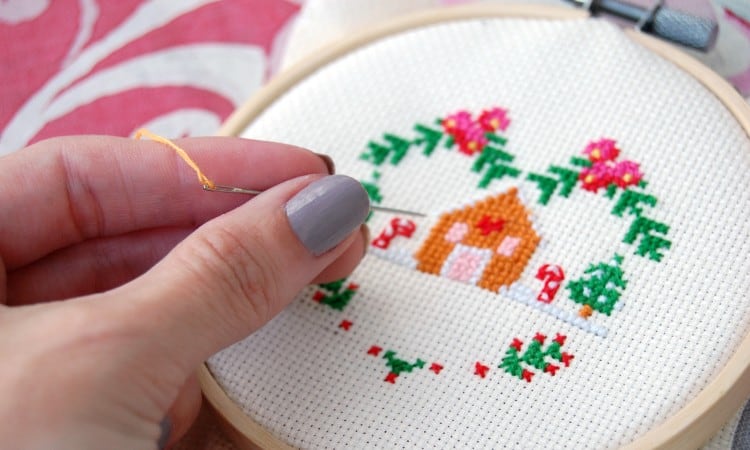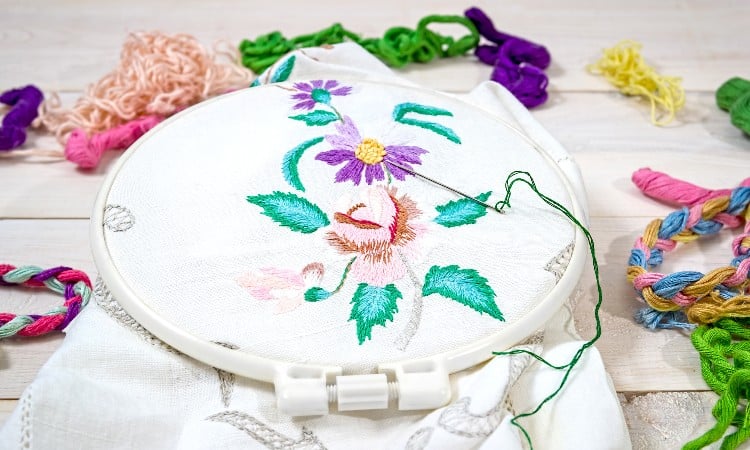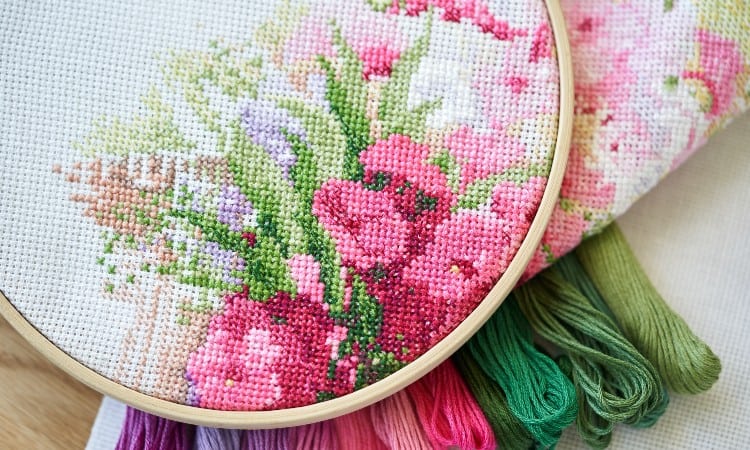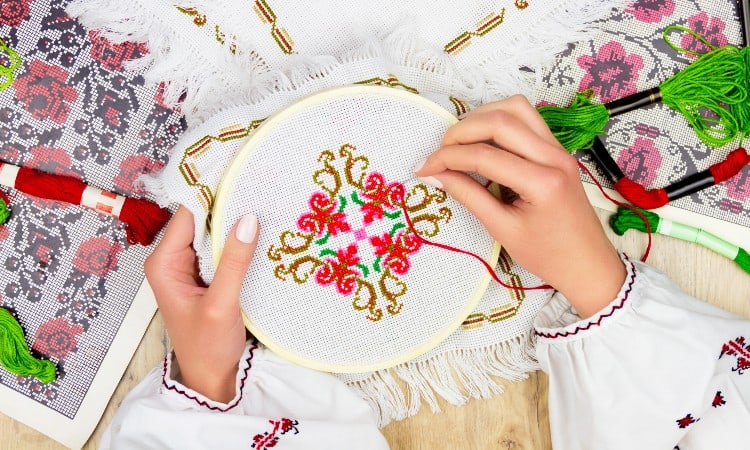If you already knitted a scarf for everyone in your family during the lockdown, you may want to move on to cross stitching! So how does cross-stitch work and how does it compare to other decorative forms of sewing? For example, when you compare cross stitch vs embroidery, what exactly is the difference?
The main difference between cross stitch and embroidery is that cross stitch is a specialized form of hand embroidery that uses X-shaped stitches. Most cross stitch designs use Aida fabric with a wide, open weave. Modern cross stitch patterns have a grid design that matches the grid in the fabric.
In this article, you will learn about the history of cross stitch. You will discover key differences between these types of decorative sewing. Finally, you find out what supplies you need to start a cross-stitch project.
Quick Navigation
- What is Cross Stitch?
- What is Embroidery?
- Cross Stitch vs Embroidery: What is the Difference?
- Should I Learn Cross Stitch or Embroidery First?
- Is Embroidery Easier Than Cross Stitch?
- Cross Stitch for Beginners
- Embroidery vs Cross Stitch vs Needlepoint
- Is Cross Stitch Still Popular?
- Cross Stitch Patterns
- Cross Stitch Kits
- Conclusion
What is Cross Stitch?

Cross stitch is a kind of embroidery that uses counted cross-shaped stitches to form designs. It has a stylized and precise design that some other forms of embroidery lack.
The earliest cross stitch designs found anywhere in the world originated in China during the Tang dynasty. Women used silk floss to create elegant patterns on clothing that used repeated X stitches during this period.
No one knows for sure, but this pattern of stitching likely made its way down the silk road along with actual silk thread. This spread the concept of cross stitches across the world.
In the 11th century, Catherine of Aragon (the unlucky first wife of the notorious Henry VIII of England) brought the idea of blackwork stitching to England.
Blackwork stitching remains popular today. It uses cross stitch patterns made of black wool thread on top of white fabric to form a high-contrast design.
Cross stitch patterns also appear in tapestries made during the Middle Ages and the Renaissance period.
Today, most modern cross stitch uses a special grid pattern. You can download these patterns online or buy them from any sewing store.
Cross stitching is called counted thread embroidery. To use a cross stitch pattern, you count out the squares on the pattern and match each square to one stitch in your design. The pattern also tells you what color of thread to use for each stitch.
At the most fundamental level, a cross-stitch is a design that uses an X-shape stitch. Here is how you make this stitch:
- To form a cross-stitch, thread a tapestry needle in the appropriate color. Do not tie off the end of the thread.
- Bring the needle up from the back of the fabric.
- Find the hole diagonally across the small square in the fabric and take the needle back to the reverse of the fabric. This should create one small diagonal stitch across a square in the weave of the fabric.
- Finally, bring the needle back through the fabric, this time starting at the hole on the other side of the bottom of the square.
- Make another small diagonal of thread that cross over your first diagonal. You should now have a small, perfect X of thread in the center of one square in the fabric!
What is Embroidery?

Embroidery is any method of decorating cloth with thread, ribbon, or even yarn. “To embroider” literally means to embellish or to make something fancy. You can find many different styles of embroidery, and cross stitch is just one of these styles.
Embroidery, in one form or another, has existed as long as humanity has used textiles. Fossilized remains dating back to the Cro-Magnon era show examples of embroidery used in clothing!
What we think of as embroidery today originated in China. The concept of stitching with silk thread likely found its way to the Western world after merchants launched the Silk Road. This trade route carried many ideas from China to the rest of the world.
In the Western world, the idea of using colored thread to decorate clothing and Church artifacts gained huge popularity during the Middle Ages. Richly embellished clothing in bright colors indicated wealth at many points in history. Because of this, learning fancy stitching techniques became an essential skill for upper-class women around the world.
Today, most embroidered clothes or other items come from an embroidery machine. These special sewing machines use a computer to direct the needle and form intricate designs. But hand embroidery remains popular as a hobby as well!
A few of the most popular types of embroidery include:
- Candlewick embroidery forms repetitive designs using a special stitch called a French knot. This creates a raised, bumpy texture over the surface of the cloth and ends up looking quite lacey.
- Crewel work uses soft wool threads to create raised designs on the surface of the cloth. This stitching method has a lot of texture but uses many basic embroidery stitches, such as running stitch and satin stitch.
- As you now know, cross stitch uses counted cross stitches in a grid pattern to make a design. This type of embroidery uses a stiff open-weave fabric called Aida cloth to make forming the X stitches easier.
- Freehand or free-motion embroidery combines many different embroidery techniques. Many freehand embroidery artists equate this style to drawing or painting with the needle, just as you would with a pen.
- Sashiko embroidery comes from Japan. This style features a running stitch in repeated patterns. This creates a minimalist, high-contrast design that often covers a large portion of a fabric or garment.
- Stumpwork is a super-interesting three-dimensional type of embroidery. Layered stitches form raised shapes that often look realistic in this style of embroidery.
- Needlepoint, also called canvas work, uses yarn stitched through a stiff open weave canvas. This method of embroidery mostly uses a tent stitch that completely covers the whole surface of the canvas.
- Ribbon embroidery combines silk floss and satin ribbons to create three-dimensional patterns. Flowers, butterflies, and hearts show up a lot in ribbon work.
- Punch needle embroidery uses a unique tool to punch through the surface of the fabric. Thie method of embroidery works a lot like rug hooking and uses a special tool to punch loops of yarn through to the surface of the fabric.
That list may seem long, but it does not even begin to cover all the types of embroidery that have developed over the years. You can also find embroidery styles that work in beads or sequins or embroidery that uses cut-out shapes within fabric or lace as part of its design, among others!
You can also think of embroidery in terms of the kind of stitches used. Some of the most popular embroidery stitches include a running stitch, chain stitch, cross-stitch, french knot, satin stitch, feather stitch, and back stitch.
You can use a cross stitch pattern for a different style of embroidery if you prefer. For example, you can choose to fill in a part of the cross stitch pattern with french knots instead of crosses if you like the contrast in texture.
Cross Stitch vs Embroidery: What is the Difference?

The biggest difference between cross stitch and embroidery is that cross stitch is one specialized form of embroidery, while the term “embroidery” covers every type of decorative stitching.
Check out this breakdown of key differences like purpose, type of stitches used, and cost of each style of stitching to get a more in-depth view.
Purpose
The greatest difference between the purpose of cross stitch and other types of embroidery is that cross stitch works very well for any design you can easily fit into a graph, while embroidery can use an infinite amount of designs and patterns.
Are you unsure whether cross stitch or another form of embroidery will work best for your intended purpose? You can also consider that cross stitch designs have a very flat appearance and look good framed on a wall. Other places you see cross stitch designs used include upholstery and throw pillows.
Every style of embroidery has its own purpose. For instance, sashiko embroidery works great for stitching together layers of fabric in clothing or covering a patch in a garment. Candlewick embroidery forms a raised, bumpy surface that would feel uncomfortable in a garment but looks lovely on a throw pillow.
Stitches
The big difference between the stitches used in cross-stitching and in other forms of embroidery is that cross-stitching uses just one type of stitch. Most forms of embroidery mix and match many types of stitches.
Cross stitch uses a cross-stitch. That’s it! You make many, many tiny X’s out of thread to complete a design.
Other types of embroidery use stitches, such as a satin stitch. This stitch uses many flat stitches placed immediately next to each other to completely cover a solid area of the fabric.
A running stitch is also a popular embroidery technique. You can form running stitches by adding straight stitches in a consecutive line.
Chain stitches start as a running stitch. Then you bring the needle back up in the middle of the thread from the previous stitch. This splits the embroidery floss to create a chain-link style stitch.
Few other types of embroidery use a cross-stitch within their designs. The exception is the old-fashioned blackwork style still used today, mostly in period costume pieces. This special embroidery style uses black wool against a white background to create a lacey pattern and is often based on cross stitches.
Fabric
Cross stitch needs a special kind of fabric, but many other kinds of embroidery will work on various materials.
Cross stitch needs a special type of fabric with lots of visible squares and open holes. Most cross stitchers use a kind of cloth called Aida fabric which is a kind of open-weave cotton.
Some other types of embroidery also need a particular type of fabric, but others will work on any type of material from velvet to burlap.
Cross stitch needs a type of material that makes it easy to translate the grid pattern to the grid and the weave of the fabric.
Many premade kits will come with this design already printed onto the cloth. This kind of kit will say that it has “stamped fabric.” If you buy a pattern, you will have to count the squares in the cloth to match the counted squares in the pattern.
Patterns
The big difference between cross stitch patterns and the patterns used by other types of embroidery is that cross stitch patterns always have a simple grid structure. To replicate the design in the pattern on your cloth, you count squares in the grid starting from the center of the design.
For many other embroidery projects, you begin by using transfer paper or chalk to put your design on the fabric you plan to decorate.
For example, suppose you want to add embroidered flowers to the hem of a cotton pillowcase. You would use washable fabric ink or chalk to draw or transfer the flower design onto the pillowcase. Then you can stitch over the design to add the pretty flowers.
Supplies
Cross stitch and many other styles of embroidery share some basic supplies. Each method of stitching needs its own unique tools as well, though.
- The frame: Both cross stitch and many types of embroidery need a hoop or stand to hold the fabric taut as you stitch. These come in varying sizes, usually in a circular shape with a screw at the top to tighten the fabric inside the frame.
- The needle: For cross-stitch, you will want to use a blunt tapestry needle that comes with a nice big eye for easy threading. Other styles of embroidery use a variety of needle types ranging from a punch needle to a sharp needle.
- The fabric: Cross stitch needs Aida fabric with a stiff, loose weave. Other types of embroidery use fabric types such as canvas, denim, or any textile.
- The thread: Most cross stitch designs need embroidery floss, usually made of silk or cotton. This type of thread contains six fine strands of thread twisted together. You may need to separate two or three strands to create a thinner and more flat design, depending on the suggestions in the pattern. Other types of embroidery often use embroidery floss, but some use wool thread, ribbon, or yarn to stitch with instead.
- The design: Almost every type of embroidery begins with a design or pattern. Kits will come with this pattern. You can also buy digital patterns to download from places like Etsy or buy whole booklets of designs from a craft or sewing store.
Cost
The cost of completing a cross-stitch or embroidery project can vary. But most of the time, all you need is the fabric, the thread, the right needle, and a frame of some sort to hold your project as you work. Each of these items costs just a few dollars from most sewing stores.
Of course, this depends on the type of project. If you want to create a cross-stitch pattern to cover an altar cloth for the local church, this will cost a lot more. You will need a large piece of fabric and an entire armful of thread!
But for your average small project meant to frame and hang on the wall, you can expect the whole project to cost ten dollars or so.
If you want to buy a cross-stitch or embroidery kit, both products will typically cost the same amount as they contain the same supplies!
That said, embroidery can cost much more than this if you want to get digital and use a computerized embroidery machine. People running embroidery businesses typically use computerized embroidery machines. This allows the business to quickly stitch hundreds of logos onto t-shirts, for example.
Popularity
Both cross stitch and other forms of embroidery remain very popular today as hobbies for people who like to work with their hands. You can’t say that one method of embroidery is more popular than another. You can easily find kits for many types of embroidery for sale everywhere, from Walmart to sewing stores these days!
You can also find many free design ideas online or buy books of patterns from your local sewing store. If you want to buy a finished piece of embroidery or cross-stitch, scroll through Pinterest or Etsy to see how many millions of options you can find!
That said, one advantage cross stitch does offer is its repetitive, simple nature. You can use cross stitch much like an adult coloring book or a basic knitting project for a calming, meditative break from your daily life. This is one of the big reasons cross stitch designs remain so popular with hobby sewers today.
Should I Learn Cross Stitch or Embroidery First?
As a beginning hand-stitcher, you will find cross stitch much simpler than most other forms of embroidery.
To cross stitch, you just have to learn one type of stitch, which you repeat in a calming pattern across a grid. You do have to count the stitches as you do while knitting. But the color-coded patterns used in this type of embroidery make the process easy to understand.
This is not to say that other forms of embroidery are necessarily that much harder. But many other styles do make you learn how to make many different types of stitches. You may also need to learn how to read patterns that use unique terminology to duplicate a design you like.
Is Embroidery Easier Than Cross Stitch?

Most other forms of embroidery are not easier than cross stitch, as cross stitch offers a simple format and easy-to-read patterns. Most other embroidery styles use a more complex array of stitches. Some use intricate patterns to list all the stitching types and colors needed.
Some types of sashiko embroidery simply need parallel lines of running stitches, so you may consider that even easier than making repetitive cross stitches!
The difficulty of a type of embroidery varies on a case-by-case basis. It depends on the kind of project you want to complete and the style of embroidery you choose. A three-inch cross stitch will probably take you only an hour or two to complete, but if you want to cross stitch the hem of a whole tablecloth, you should plan to work on that project for a month or so!
Cross Stitch for Beginners
Cross stitch is the perfect form of embroidery for a beginner because it requires little practice and no special skill.
You do need to learn how to form a cross-stitch. This stitch uses two diagonals facing opposite directions like this: / \. You place one diagonal stitch across the other to form an X. You may want to watch a Youtube tutorial if you learn better visually.
Unless you buy a kit with the design printed onto the cloth, you will also need to learn how to read a cross stitch pattern. This works a lot like a paint-by-number, though! Just match the rows and squares of the gridded pattern to the rows and squares in your fabric, and then select the right color of thread to match each section of the pattern.
Here are just a few suggestions for beginner-appropriate cross stitch ideas:
- Stitch a heart or a smiley face onto the top of a bookmark as a gift. You can use just one color of thread for the easiest project or vary the color of your stitches for a more interesting pattern.
- Trace a large heart-shaped cookie cutter onto your fabric using chalk. Cross stitch over this outline to form a heart. Then sketch in the names of you and your family inside the heart, and use cross stitches to “write” with stitching over the names!
- You could also consider buying a beginner-level kit to help you learn the basics of cross stitch. You can find kit recommendations later in this article!
Embroidery vs Cross Stitch vs Needlepoint
The biggest difference between embroidery, cross-stitch, and needlepoint is that both cross stitch and needlepoint are forms of embroidery. Embroidery just means any type of decorative stitching on fabric, while cross stitch and needlepoint have a particular style and type of stitching.
Needlepoint has more similarity to cross-stitch than any other type of embroidery. Needlepoint works a design onto a flat surface, usually a stiff canvas. It can even use cross stitches in some patterns, though it mostly features tent stitches, basketweave stitches, and a continental stitch.
Unlike cross stitch, needlepoint always covers the entire surface of the fabric, though.
Is Cross Stitch Still Popular?
Cross stitch is definitely still popular as a hobby and for home decor. If you doubt this, simply Google “cross stitch design” and see how many results spring up! You can find finished cross stitch art for your walls or buy pillowcases or hand towels with cute designs stitched onto them.
And, of course, you can buy patterns to make your own cross-stitch art, too! Plenty of these feature traditional sayings like “Home Sweet Home,” but you can also find plenty of witty, funny, or downright vulgar sayings if you have a more lively sense of humor!
Cross Stitch Patterns
You can buy cross-stitch patterns online or from a sewin store, or you can find and download free designs. If you feel crafty, you can create your own pattern pretty easily, so long as it translates to a grid.
Some of the best places to buy cross stitch patterns include Etsy, Amazon, and sewing stores like Joann Fabrics and Hobby Lobby. You can buy a whole book of patterns quite cheaply. You can also request custom patterns from artists online in some cases.
If you want free designs, Google “free cross stitch pattern,” because many artists post occasional freebies to their blogs! You can also check out your local library to see if they have a book or two of cross-stitch patterns available for checkout.
Cross Stitch Kits
Cross stitch kits offer a super-easy way to approach cross stitching because the kit contains all the supplies and instructions necessary to complete a design. This is the perfect way to start learning cross stitch as a beginner. It also takes all the stress out of cross stitching, even as an expert if you just want a relaxing hobby!
Maydear Designs
 This kit offers a simple design created for a beginner cross-stitcher. You can select from eleven adorable designs like a bird perched on an elephant or a ladybug on a mushroom.
This kit offers a simple design created for a beginner cross-stitcher. You can select from eleven adorable designs like a bird perched on an elephant or a ladybug on a mushroom.
The kit contains a cute flower-shaped hoop for framing, cloth stamped with the design, and the necessary embroidery floss in appropriate colors. It does not come with a tapestry needle, though, so you will need to buy that separately.
Santune 3 Sets
 This set of intermediate-level cross stitch designs allows you to create three different 8-inch designs. You can choose from designs that look like Monet’s paintings, butterflies and bees, sunrises, or many flower patterns.
This set of intermediate-level cross stitch designs allows you to create three different 8-inch designs. You can choose from designs that look like Monet’s paintings, butterflies and bees, sunrises, or many flower patterns.
Though this kit will take quite a lot of time to complete, you will end up with a professional-looking work of art to hang in the 8-inch bamboo hoop that comes with the kit. The kit also contains fabric stamped with the pattern for easy stitching, needles, and embroidery thread.
Conclusion
The key difference between cross stitch and embroidery is that cross stitch is a specialized form of embroidery. Cross stitch uses just one type of stitch formed by placing two diagonal stitches over each other to make an X. Other types of embroidery use various stitches, such as satin stitch and running stitch.
Cross stitch designs come laid out in a grid to match the visible squares in cross stitch or Aida fabric. Other kinds of embroidery can work on many different types of materials like cotton, denim, or velvet. Because it uses simple grid patterns and one type of stitch, cross stitch is one of the best kinds of embroidery for a beginner.
Have you ever made a cross-stitch design? Did you like the simplicity of this embroidery technique? Leave a comment below to let us know!